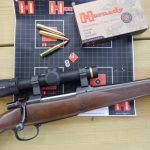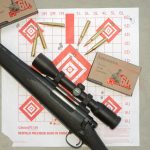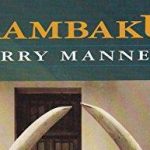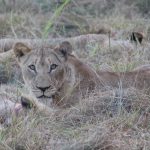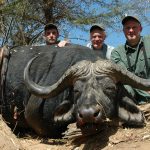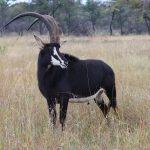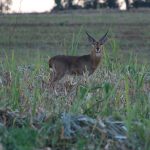It’s .375, right? Actually, it’s not that simple.
Photo above: Donna Boddington took this Mozambique swamp buffalo in November ’22 with her MGA in .376 Steyr, using 270-grain Hornady Interlock. The bull dropped and was anchored by the first shot; a second insurance shot was fired, but probably wasn’t necessary.
“.375 is the legal minimum for buffalo.” This is said so often that it’s taken as an article of faith, but it’s rarely true. Not all African countries have minimum legal calibers. Of those that do, the European equivalent 9.3mm (.366-inch) is the most common actual minimum. Some caveat caliber with minimum bullet energies, sort of a dual minimum.
The concept is good. The days when the ivory hunters waded into herds with 6.5mms, 7mms, and .303s are long past; today’s intent is to take one legally authorized animal, and do it cleanly with minimal danger to the hunting party and local residents. But how much bullet weight, velocity, and energy are really enough? Almost impossible to define because no two shots are exactly alike, and no two animals react exact alike upon receiving a bullet.
Minimum caliber is simplest, but confusing because of different case dimensions with varying power levels. If the minimum is “.375,” then the .375 Winchester would also be legal. Great for black bear, but not a buffalo cartridge. The late Don Heath, long with Zimbabwe Parks and Wildlife, was a staunch 9.3mm guy. He manipulated Zimbabwe’s “minimum energy” levels to ensure the 9.3×62 and 9.3x74R made the cut.
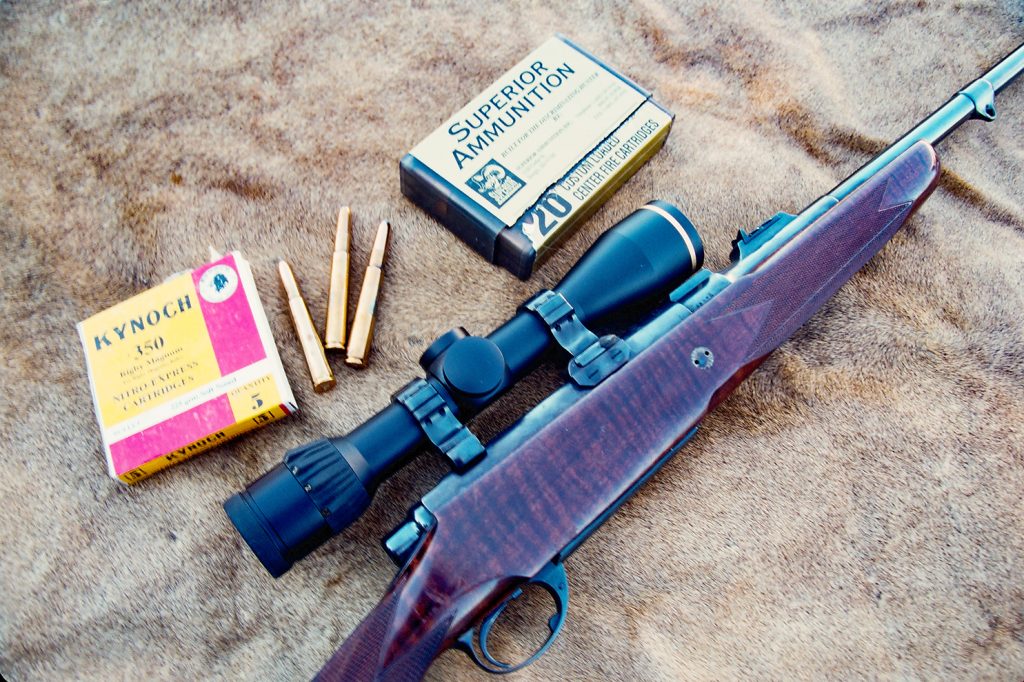
I agree. Both are sensible and sound minimums for buffalo, and both on the light side for elephant. But, for buffalo, how much gun do we really need? Because of the absolute necessity to obey game laws, few today have much experience with cartridges/calibers less than 9.3mm or .375. I’ve always figured that an African buffalo is in the same size/weight class as a big Alaskan brown bear, maybe three-quarters of a ton. The .375s are great medicine for big bears…but so are the .338s. So why not?
In the day, the .318 Westley Richards (250-grain .330-inch bullet) was widely used. With a 300-grain bullet, the .333 Jeffery (literally a .333-inch bullet) was probably even better. The .333 and its heavy bullet inspired Elmer Keith’s experimentation with .33-caliber wildcats. Keith used at least one of these in Africa with Bob Petersen. The photos I recall show him with a lion and a roan antelope. He took his elephants with big doubles, and it’s not clear if he used .33s for buffalo. A long time ago, I took one buffalo with a .338 with 250-grain Swift A-Frame. I had a good rest on an antheap and could visualize the high-shoulder spine shot. Not a shot I recommend, but if certain, it’s lights out. The buffalo down and dead, no insurance shot required.

The .35s also have potential. The .350 Rigby Rimless Magnum (1908) was John Rigby’s first unbelted rimless cartridge with little body taper. Three years later, the .416 Rigby was essentially its big brother. For larger game, the .350 was hampered by a light 225-grain bullet at a then-fast 2,600 fps. For sure, it was used on buffalo. Modern .35s, with modern 250-grain (or heavier) bullets would be a better bet. Recently, a friend took a buffalo with his .35 Whelen Ackley Improved, one shot with a 250-grain bullet, no problem. The faster .358 Norma Magnum, though uncommon, certainly has the theoretical horsepower for buffalo.
Is this a useful discussion? I’m not sure, but it falls in with current thinking. Here in North America, “going minimal” seems in vogue, with .22 centerfires now legal for deer, and mild 6.5mms widely used for elk. In Africa, we have specific caliber minimums to follow, so this is mostly theoretical. But, at modern velocities with our exceptional bullets, it’s interesting to speculate on how the .33s and .35s might stack up.
Such restrictions are almost unique to Africa. Alaska and Canada don’t have different caliber criteria for big bears. Such restrictions also don’t exist in Asia, Australia, or South America, where other large bovines (mostly water buffalo) are hunted. Generally speaking, water buffalo aren’t as aggressive as their African counterparts. However, water buffalo are considerably bigger than Cape buffalo…and not all of them have read the script. A prominent and well-experienced Mexican hunter was recently killed by a water buffalo in Argentina.
Water buffalo should not be taken lightly but, absent specific legal criteria, I’ve taken the opportunity to experiment a bit, using 7mms, .30-calibers, and .35s. With heavy-for-caliber expanding bullets (or solids), the light calibers (7mms and .30s) worked wonderfully. The .35s, .350 Rem Mag and .35 Whelen Ackley Improved, were unimpressive, multiple shots required. I put this down to too-light bullets. The only available option was 225 grains; results might have been more impressive with 250-grain bullets (or heavier).
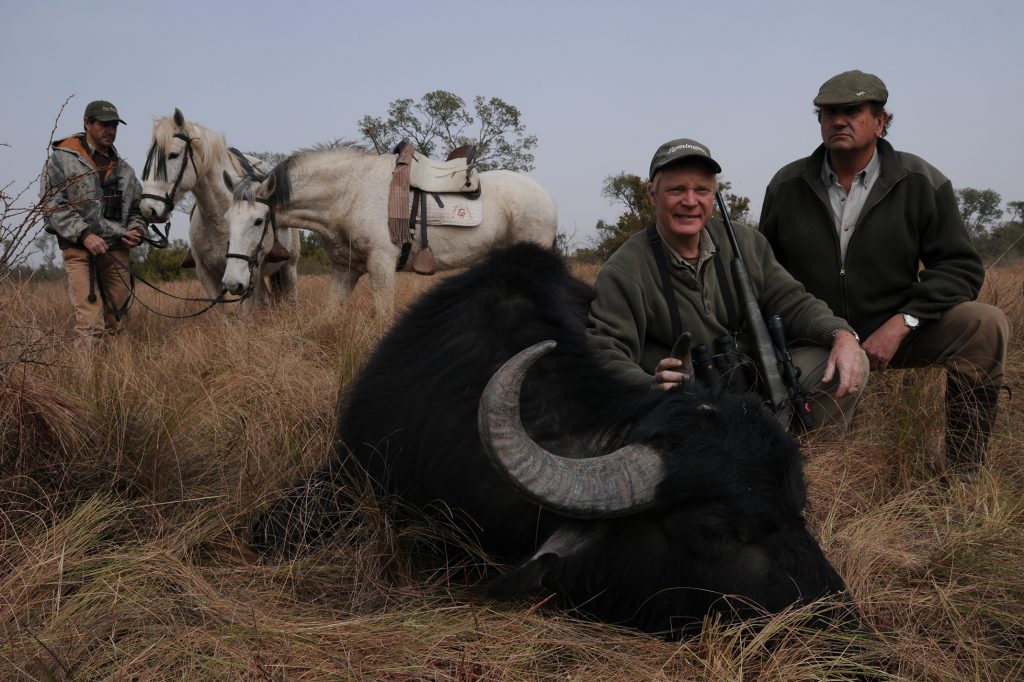
Two problems with all that stuff: First, samplings are too small to draw conclusions. With African minimums in place for decades, below the standard minimums of 9.3mm and .375, there isn’t much data, and almost none with modern bullets. Second, with buffalo one must play the “what if” game. If things go wrong, bigger is better for stopping a charge so, where legal, if a lighter cartridge is chosen, somebody best be on hand with a heavy rifle!
Now, from .375 H&H upwards, what works on buffalo is pretty well known. The .375s are fine, the .416s a bit more decisive, the big bores more dramatic yet, but not essential. Although the spectrum is narrow, there is value in considering minimal options, simply because of recoil. On buffalo, where we hit them, and what bullet we hit them with, are more important than caliber, case dimensions, or even velocity and energy.
Shooting at buffalo is no different than anything else: Most people place their shots better with cartridges that are easy to shoot. And, nobody shoots well with cartridges we are afraid of. Most people can learn to handle a .375 H&H, but too many gravitate to more powerful cartridges. Faster, harder-kicking .375s; slower, harder-hitting, and harder-kicking .416s; on up to big bores. With equally good shot placement, all may take a buffalo down a bit more quickly. However, dead from a well-placed, minimally adequate shot beats wounded by a bad shot from a more powerful cartridge.
It’s still about shot placement. I’ve seen buffalo missed clean, and wounded and lost, with very big guns, including .500 Jeffery and .505 Gibbs. Maybe the same would have happened with smaller, lighter, easier to shoot cartridges…but maybe not.
So, what easy-to-shoot legal options do we have? House the .375 H&H in a heavier rifle and it’s more manageable. Also, consider bullet weight. Since 1912, the 300-grain bullet has been the standard .375 formula for larger game. With the great bullets we have today, buffalo can be taken very effectively with tough 250 and 270-grain .375 bullets, which produce less recoil.
Which brings us to the 9.3mm alternative. The 9.3×64 and the .370 Sako Magnum (9.3×66) produce about the same power as the .375 H&H, so neither offer lighter recoil. The 9.3×62, dating to 1905, was designed to replicate, in bolt actions, the performance of the older 9.3x74R in double rifles and single shots. With 286-grain bullet at 2,360 fps, they do not equal the .375 H&H’s 300-grain bullet at 2530 fps, but they are long-proven adequate for buffalo, and are street-legal in all African jurisdictions.
Recoil is milder…if gun weight is similar. I have a little Sabatti 9.3x74R. It’s amazingly accurate for a double, but it only weighs six pounds. It is not a low-recoil option! In fact, it’s a hard kicker, but it’s accounted for buffalo with a single shot. In a bolt-action of reasonable weight, the 9.3×62 is a lower-recoil option. With 117 years of use in Africa, we know the 9.3×62 is adequate for buffalo, and it’s easier to shoot than larger cartridges.
Other options are few, but there is one more. In 1999 Hornady teamed up with Steyr to create the .376 Steyr around Jeff Cooper’s “big bore scout rifle” concept. Based on the 9.3×64 case necked up to .375, it propels a 270-grain bullet at 2600 fps, producing just over 4000 ft-lbs. So, on paper, unquestionably adequate. It has not been among Hornady’s greatest successes, but we happen to have one.
Donna’s .375 H&H is on a Blaser action with a stiff barrel. Heavy enough, she handles it just fine and we’ve both shot multiple buffaloes with it. Years ago, I thought it would be a good idea if she had a lighter, handier buffalo-capable rifle, so I got Kerry O’Day at MGA to build her one. Kerry recommended a 9.3×62 but I insisted on the .376 Steyr. At the time, I didn’t predict that the .376 would become…uncommon. We’ve used it a bit, but never on buffalo. Long curious, I thought it was about time, so she used it for a Mozambique swamp buffalo in November ’22, hunting with young PH Xavier Schutte. Hornady factory load, 270-grain protected-point Interlock, shoulder shot at sixty yards. Her buffalo dropped to the shot, then tried to struggle up as they approached. A second shot at thirty yards put him down again to stay.
The .376 Steyr is not as powerful as the .375 H&H…and kicks less. Although faster than the 9.3×62, the .376’s lighter bullet has lower Sectional Density, so I’d rate them similar in performance. Bullet weight and velocity differences between the two wash each other, so felt recoil is also about the same. As always, one animal proves nothing, but I’m convinced I was right all along: The .376 Steyr is buffalo-capable, fully street-legal, and therefore among our very few reduced-recoil options.



